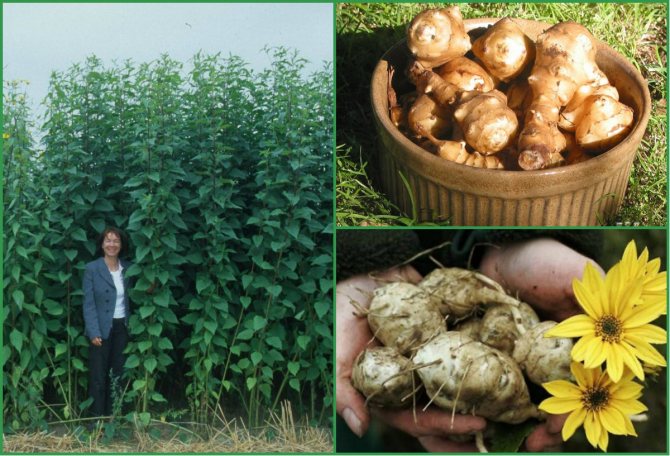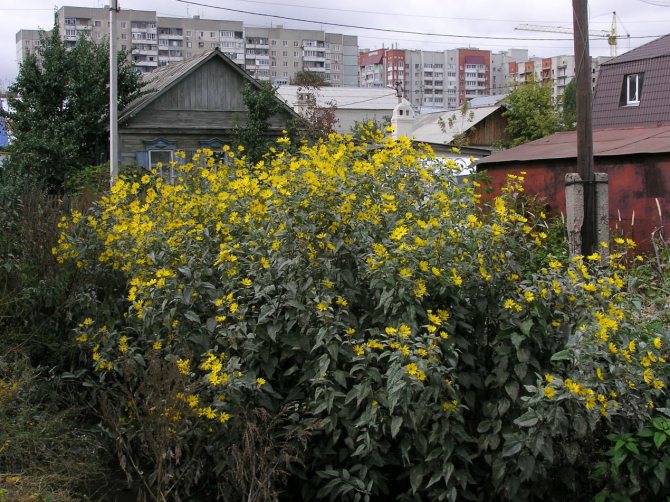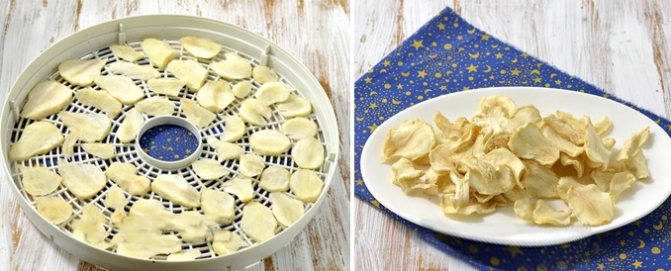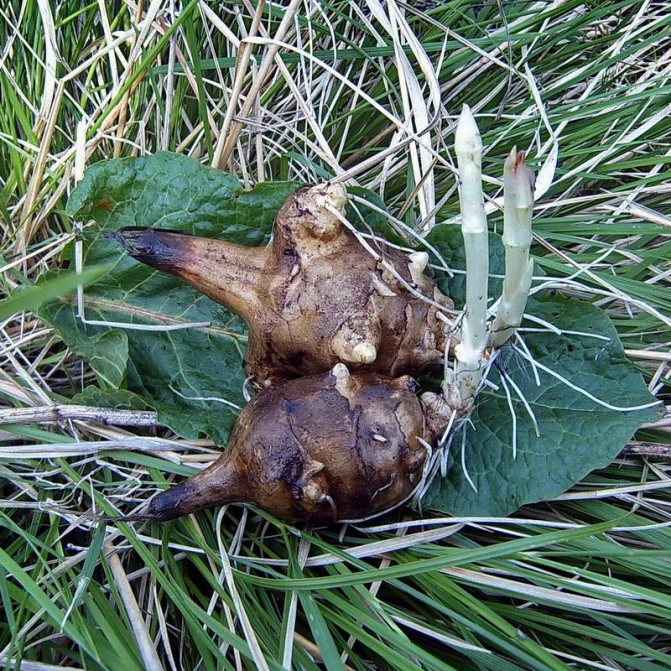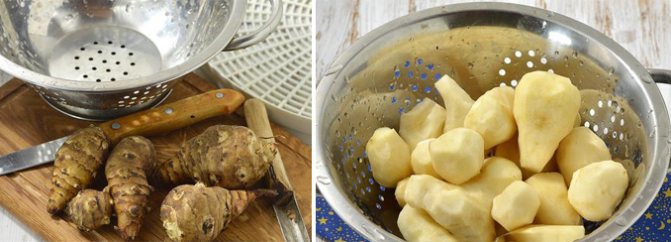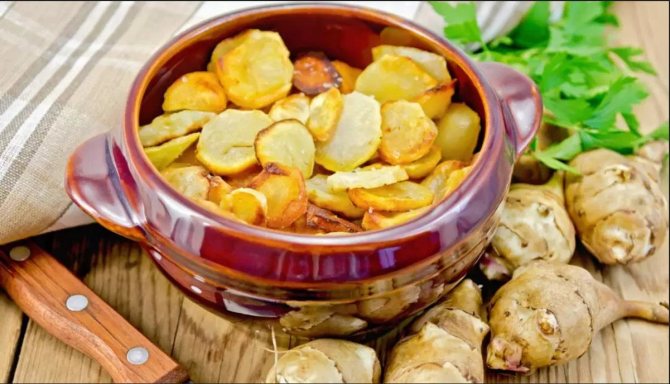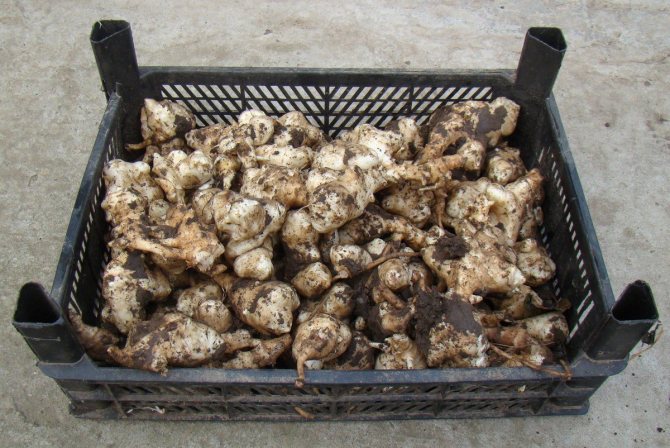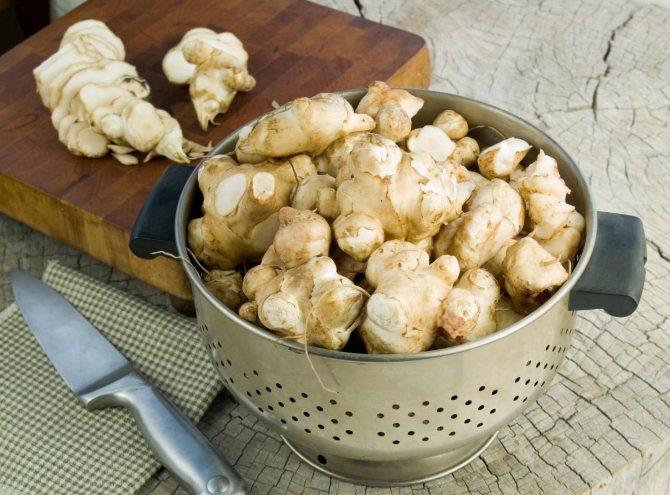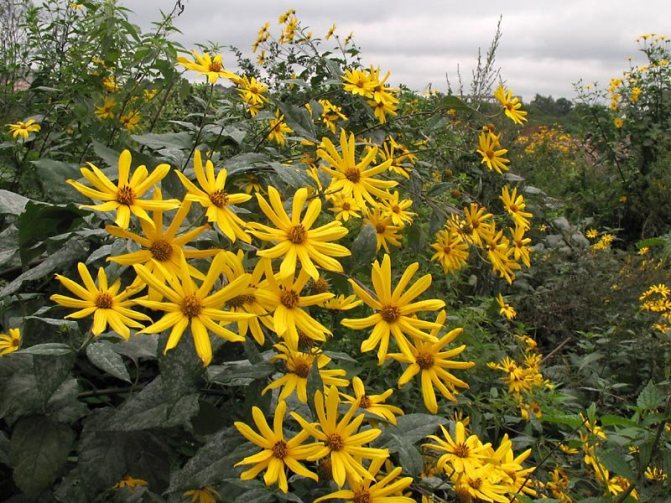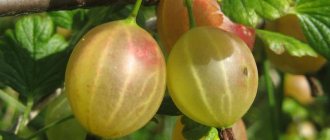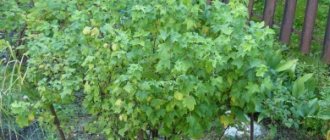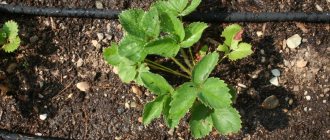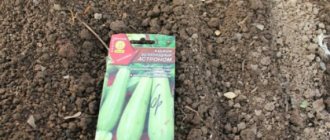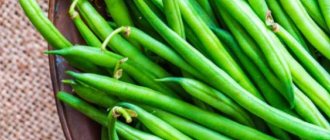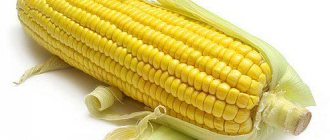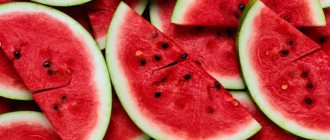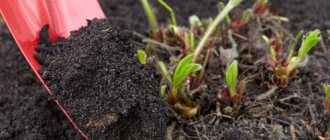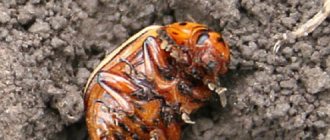Cooking Jerusalem artichoke
Before using the tubers, they should be thoroughly washed. Some people use them raw, while others prepare a variety of healthy dishes from it.
Since all parts of the vegetative mass of the plant are useful, various medicinal decoctions are prepared from flowers. Young leaf plates are used in the manufacture of salads or coarser leaves are used for pet food. Tubers are used in various areas of cooking. There are many recipes for this healthy herb.
Jerusalem artichoke salad
For this purpose, take the right amount of tubers, rinse well in running water. Then peel and rub on a coarse grater, add finely chopped parsley and green onion feathers. Salt everything and season with sour cream, mayonnaise or sunflower oil.
Autumn salad
Add sauerkraut to taste and red apples cut into squares to the peeled and coarsely grated Jerusalem artichoke. The ratio of Jerusalem artichoke tubers, cabbage and apples is 2: 2: 1. Everything is poured with a small amount of sunflower or olive oil, salt and parsley and dill are added.
Summer radish salad
Well-washed tubers of radish and Jerusalem artichoke are rubbed on a coarse grater. Cut green onions and parsley into small pieces and pour over the grated tubers. Then salt the salad to taste and season with sour cream.
Decoction
The broth increases hemoglobin and lowers blood pressure. To prepare it, you need to take 3 tablespoons of dry roots and pour boiling water over 1500 gr. and putting on a small fire, simmer for an hour. A decoction without sugar is taken three times a week, 500 g each.
Infusion
Jerusalem artichoke infusions are used for various colds and stomach ailments. For this purpose, one tablespoon of chopped tuber is poured into 800 gr. boiling water. It should be infused in a dark place up to 12 hours. Then everything is filtered and the infusion is stored in the refrigerator. Take 100 gr. three times a day on an empty stomach.
Tincture
500 gr. the dried leaves are poured with a liter of alcohol or vodka and stored (infused) in a dark cool place for 20 days. Apply it one tablespoon three times a day. But before use, it is worth diluting it in 150 grams. water.
Syrup
Syrup can freely replace sugar, it is especially valuable for people with diabetes mellitus. Also, syrup reduces the need for insulin, as it stabilizes the state of blood sugar. The syrup has no side effects and can even be taken by children.
When to collect leaves for tea
At the end of autumn, all the nutrients from the shoots flow into the tubers. The best moment to harvest the leaves: the flowering period. By the way, the inflorescences have useful properties and are brewed both together with the foliage and separately.
For the safety of the collection, the ingredients are carefully dried. A hot room with low humidity levels is ideal for this purpose. The main thing is to avoid direct sunlight, which destroys the vitamins contained in the plant. An electric dryer is not the best option for leaves. Drying up, they crumble, falling through the grates. It turns out a lot of rubbish.
When the collection is dry, it is advisable to pour it into a clean dish, tightly closing the lid. Some housewives sew special handbags from natural fabric. After filling, they are tightened tightly. With this storage, the inflorescences "breathe" and deteriorate less.
Watch the video for a detailed process of collecting leaves and their further processing:
What time is it harvested for eating

There is no need to rush to collect the entire crop of the earthen pear. The tubers do not have a long fresh shelf life. They can be stored unchanged for 1 month. After that, their appearance, chemical and biological composition changes, moisture is lost, and decay begins. They cannot be canned or dried.
The way out is in the peculiarities of the tubers not to lose their properties and appearance during wintering directly in the beds. In soil under snow or a small layer of dry earth, they can withstand air temperatures below -30 degrees. It is necessary to use this opportunity to preserve the harvest. Therefore, the best solution would be to remove some of the tubers in late autumn (after the first frosts), and leave the other part to winter in the soil, sprinkling it on top with a layer of dry soil or snow.
Is it possible to harvest an earthen pear in spring? In spring, for food, the crop can be harvested as the ground thaws and in the amount necessary for food for a week, a maximum of two. You should try to dig up the entire remainder of last year's harvest before the tuber overgrowth begins, when the new growing season of the plant starts. The main thing is not to miss the deadline. The dug tubers are immediately used for spring planting.
Reference! Experts believe that tubers left for wintering in the soil taste better in spring compared to the taste of tubers that are harvested in autumn. But the sweetness is felt stronger.
Step-by-step instructions for digging tubers
The following scheme for digging tubers is recommended:
- From the beginning of October (or even from the middle of September), dig up useful roots for preparing salads and other dishes as family needs.
- In late autumn, harvest part of the crop for food or animal feed, calculated for 1.5-2 months.
- From late autumn to spring harvest, use wintering tubers (if they can be easily dug out). In winter, the body simply needs vitamins!
- In the spring, vitamins are needed even more due to the inevitable seasonal vitamin deficiency of the human body. Therefore, a garden bed with natural vitamins in the garden will be of great help to health that has weakened over the winter.
Jerusalem artichoke is collected in this way:
- Before harvesting Jerusalem artichoke, you need to cut off all of its bushes throughout the entire area. Regardless of whether part of the crop will remain under the snow until spring or not.
- Leave a stump 30-40 cm long from the stem of each plant. This shoot will serve as a guideline for the subsequent digging of tubers in the fall or spring. The shoot will probably almost rot before spring and will not help in extracting tubers even from loose soil, but it will indicate exactly where they are.
- Further - a matter of technology, well known to everyone from many years of experience in harvesting potatoes. You can dig it with shovels, but it is more convenient to do it with a pitchfork. The pitchfork should have a not too wide space between the teeth (Jerusalem artichoke tubers are much smaller than potatoes). It is easier to dig with a pitchfork, and the tubers are less damaged when working with such a harvesting tool.
The tubers are folded into buckets or small boxes, and then transferred to a place of permanent storage. If the land is dry during harvesting, then drying the crop is not necessary. In the case of wet soil, it is required to dry the Jerusalem artichoke before storing it. But in no case should you wash the tubers!
Jerusalem artichoke - pests and diseases
Although it is believed that the earthen pear is not susceptible to disease, climatic conditions or improper care can lead to unpleasant consequences.Mold on stems and dark growths are signs of white rot. A disease occurs due to high humidity and a sharp drop in temperature. You cannot help the plants, remove the infected stems along with the tubers and burn them immediately.
It will not do without powdery rot in a rainy and hot summer. The manifestation of the disease can also be provoked by you, introducing a lot of nitrogen. Do you want to know the signs of the disease? This is a dense, light bloom on the leaves, which eventually turns into a solid gray crust. It is necessary to fight powdery mildew with fungicides, but if the disease has affected the entire plant, then it is better to get rid of it.
Dark spots on plants, drying of shoots and leaves are a sure sign of Alternaria. Fungicides will also help here, but do two treatments to be sure to get rid of the disease.
What pests threaten your Jerusalem artichoke? They especially love to feast on juicy tasty slug leaves. If the bed is large, then manually collecting the pest will not work; purchase granules for dealing with slugs in a specialized store. Having spread them all over the site, after a while you will notice that the eaten leaves have become much less.
The larva of the May beetle, the eternal enemy of summer residents, will also not ignore the juicy tubers. Try to regularly loosen the soil, choosing a pest, and while planting Jerusalem artichoke, add Foksim to the soil - an excellent tool to get rid of underground encroachments.
Optimal planting time
As mentioned above, the exact date depends on the region where you land. Planting is carried out in autumn (from late September to early November), earlier in the northern regions, and later in warmer regions. They are guided by the time of planting the garlic. The soil temperature should be at least 7-10 degrees.
Important! Tubers should not germinate before frost.
You can also plant Jerusalem artichoke in the spring (late April - mid June), when the soil warms up to 13-16 degrees. In this case, you should focus on the time of planting potatoes, most often they coincide.
- Middle zone of Russia. Spring planting here usually falls on the May holidays. Autumn falls in late September-early October. According to popular belief, planting should be completed before the Cover of the Day (October 14).
- Ural. Summers in this region are short and winters are cold, so it is better to choose varieties with a minimum growing season. The required temperature for spring plantings occurs around the second half of May. But frosts are also possible, which must also be taken into account when choosing a planting time. Spring planting is recommended in mid-October.
- Siberia. For this region, the presence of a short summer and even more severe winters compared to the Urals is also true, so the more early ripening the Jerusalem artichoke variety, the better. Here, late May-early June is optimal for spring plantings. The time of autumn planting practically does not differ from the time in other regions, and depending on the autumn temperature of this season, it is carried out in the second half of October.
Autumn plantings are made about a month before the onset of frost.
Winter planting is possible even in rather cold regions of Russia due to the frost resistance of the plant. Jerusalem artichoke tubers under the ground can withstand temperatures down to -45 degrees, and even survive cold winters in the ground well.
Jerusalem artichoke has many vitamins and minerals with health benefits. And to use a self-grown earthen pear means to bring invaluable benefits to your health and the health of your loved ones.
Materials from the section Jerusalem artichoke
Subsections: Medicinal properties
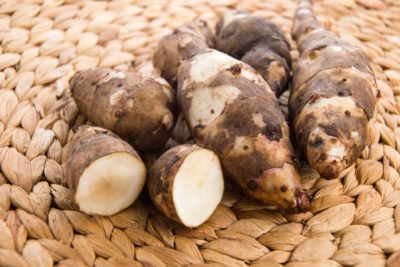

How to plant Jerusalem artichoke in spring and how best to do it?
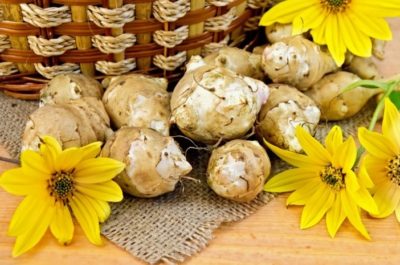

A useful and unpretentious root vegetable is Jerusalem artichoke. Growing and planting rules, as well as care recommendations
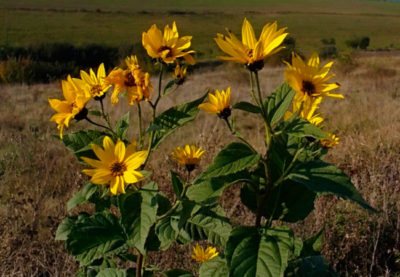

When to plant Jerusalem artichoke and when is it better to do it in different regions?
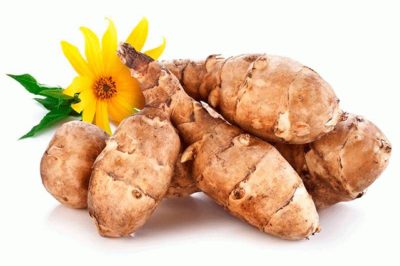

How not to be mistaken in choosing a variety of Jerusalem artichoke? Description of species and their photos
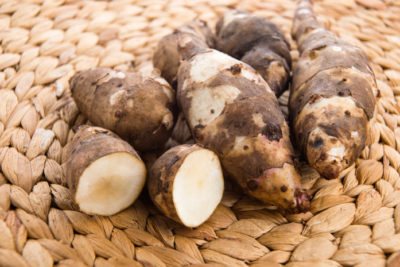

A storehouse of vitamins - Jerusalem artichoke: calorie content, chemical composition, BJU content, as well as benefits and harms
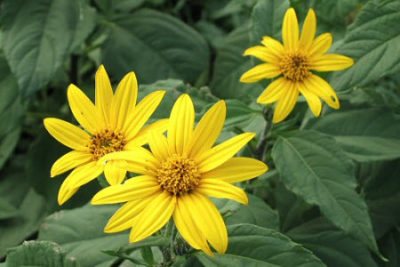

What do Jerusalem artichoke flowers look like and what are they used for? The best folk recipes for decoctions and infusions
How to tell if an earthen pear is ripe?
Agrarian science knows the timing of the full ripening of an earthen pear: depending on the variety, they range from 120 to 150 days from the moment of germination. The early varieties ripen 120 days after flowering, while the middle and late varieties mature a month after them.
Spring planting of tubers occurs in already warmed soil, therefore, in the southern regions of the country, Jerusalem artichoke is planted in mid-April, in the middle lane - at the end of April or early May, in the northern part - at the end of May. Taking into account these terms, adding 20 days before the emergence of shoots, you can easily determine the complete readiness of the tubers for harvesting. For the middle lane, the first decade of October is considered the optimal ripening time for an earthen pear.
From the first days of October, they begin to cut off the ground part of the plants, if it is needed for forage purposes or in any household preparations, and from the middle of the month you can harvest the tubers. But if the green mass is not used by the owners in any way, and they leave it on the site, then the best visual definition of the ripeness of the tubers is the beginning of wilting of the leaves of the culture (they change color and dry out).
Cultural history
The homeland of the earthen pear is North America, where it grows wild and was introduced into the culture by the Indians before the appearance of Europeans there. The first European countries with this vegetable in 1610 met England, then France, where the earthen pear was called Jerusalem artichoke (from the name of the Brazilian Indian tribe - tupinamba). The earthen pear proved to be so prolific that 20 years after its appearance, it was sold at affordable prices in the markets of England. In Holland and Belgium, Jerusalem artichoke was boiled in wine with butter, making it look like the bottom of an artichoke. In Belgium, it was even called the "underground artichoke".
In the 18th century, the spread of potatoes drastically reduced the consumption of ground pears. In 1844, the French scientist J. B. Boussingot began to praise her, declaring her unjustly forgotten.
Jerusalem artichoke has again attracted the attention of lovers of gourmet food.
In Russia, the earthen pear was known in the 17th century, but not as a vegetable, but as a medicinal plant. Tsar Alexei Mikhailovich ordered to interrogate all healers about the methods of healing they knew and the medicinal herbs that they had ever used. The healers reported that they were treating heart diseases with an earthen pear infused with wine. At first, it was prepared and served as an exquisite dish, and only in wealthy homes. Recipes for preparing dishes from unusual tubers appeared in cookbooks. In the 18th century, Jerusalem artichoke was sometimes confused with potatoes, considering it as a variety.
| It is of primary importance when returning to special areas that are unsuitable for another culture, for example, on the slopes of deep ravines in the middle chernozem zone, where it can remain for several years, shading and protecting mowing in the hollows, like a young underbrush, and eliminating the need for autumn plowing of these places since the tubers can be picked in the spring. |
In the 30s of the XX century, the vegetable grower A.A.Valyagin promoted the earthen pear as a very fruitful, frost-resistant and unpretentious crop. It is known that in those years in the USSR, with the participation of N.I. Vavilov, a decision was made on a wider cultivation of Jerusalem artichoke in collective farms, where its high yield was confirmed. However, an attempt to collect and store it like a potato (despite the fact that even a slight damage to the tuber led to a quick spoilage of the latter) led to large losses in the Jerusalem artichoke yield during storage after the autumn digging.
The widespread distribution of potatoes in Russia, as well as the unaccounted for difficulties and peculiarities of storing the Jerusalem artichoke crop, forced to postpone dreams of the latter as a valuable food crop. Jerusalem artichoke to this day is perceived as one of the most outlandish vegetables.
After 1991, with the development of small and medium-sized businesses in Russia, Ukraine and other countries of the former USSR, the plantings of Jerusalem artichoke began to increase again, including for the manufacture of a number of medicinal products (for example, Jerusalem artichoke, Dolgolet, etc.), valuable additives for the food industry, etc.
When to dig up Jerusalem artichoke
Compliance with the optimal harvesting time is one of the components of the success of growing any agricultural crop. The Jerusalem artichoke harvest is ready for harvest at the end of autumn. But many gardeners prefer to leave it in the garden until spring. What is the reason? When to dig up Jerusalem artichoke?
Jerusalem artichoke is often recommended to be eaten instead of potatoes. And in taste, he strongly resembles him. But, unlike potatoes, it is almost impossible to preserve the tubers of this sunflower relative until the end of winter, even in a cellar.
- a decrease in the content of uric acid directly in the blood serum;
- increased capillary permeability;
- strengthening the immune system;
- stimulating the production of adrenal hormones;
- elimination of harmful compounds leading to the development of malignant neoplasms in the gastrointestinal tract.
Jerusalem artichoke against excess weight
The ability of Jerusalem artichoke and its derivatives to reduce body weight, with its initial excess, has been proven in a number of clinical and experimental studies.
The course appointment of Jerusalem artichoke led to a significant improvement in carbohydrate and fat metabolism, a decrease in the level of insulin in the blood, reflecting an improvement in the sensitivity of cells to this hormone, and, as a consequence, a decrease in body weight.
Of course, we are talking about a wonderful weight loss of 20 kg per month, and about the systematic and gradual restructuring of all types of metabolism. That is why weight loss when using Jerusalem artichoke powder as a food supplement usually becomes noticeable after 3-4 months. But in some cases, it is possible to achieve noticeable weight loss during the first month of taking the product. The speed of onset of this effect of Jerusalem artichoke concentrate largely depends on the individual characteristics of the organism.
However, even if weight loss is less than desired and expected, time should not be considered wasted. The fact is that the positive changes occurring in the body have a beneficial effect on the course of many serious diseases associated with obesity: blood pressure decreases, angina attacks become less frequent and weaken, the risk of vascular accidents (myocardial infarction, cerebral stroke) decreases, exacerbations of cholecystitis are prevented and pancreatitis.
The combination of an optimal nutritional and physical regimen in combination with the use of Jerusalem artichoke derivatives makes it possible to achieve the desired result in the situations described.
By eating Jerusalem artichoke, you can only get rid of that excess weight, which is caused by a violation of the binding of insulin to the cell wall. For a greater effect of weight loss, it is necessary to use additional methods: getting rid of bad habits: smoking, alcohol, coffee, a sedentary lifestyle; low-calorie diet; increased physical activity;
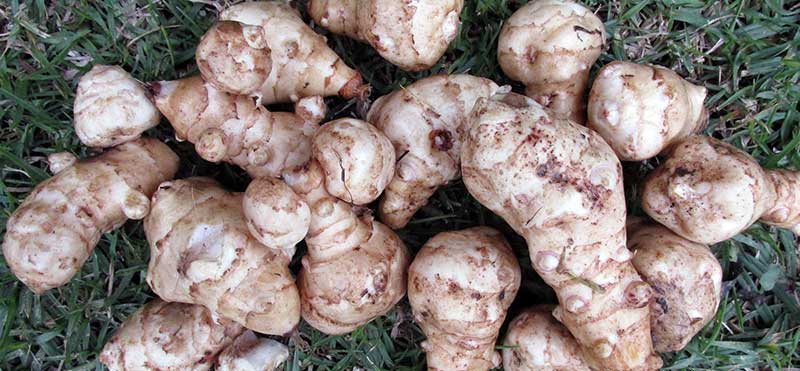

General information
Jerusalem artichoke is a perennial plant belonging to the genus Sunflower of the Astrov family. The homeland of this tuberous vegetable is North America, where it still grows wild. Jerusalem artichoke came to Europe at the very beginning of the 17th century, to Russia - also in the 17th century in two ways at once - from Europe and China, and at first it was used as a medicinal and ornamental plant.
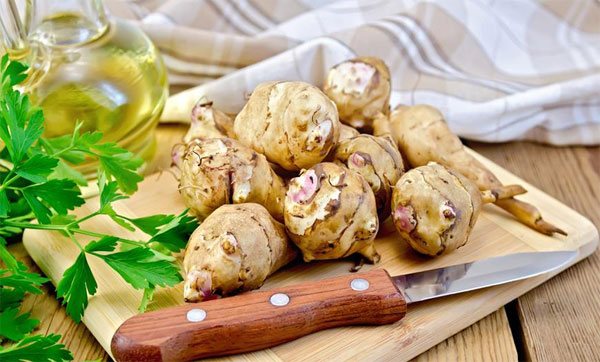

Jerusalem artichoke is a plant in an agricultural sense, simply unique: it is very unpretentious, can grow on almost any soil and in any climate, withstand heat and cold, stay in one place without replanting for decades and at the same time produce excellent yields from year to year. That is why it is grown in almost all countries of the world.
In an earthen pear, not only nutritious and vitamin tubers are valuable, but also green mass, which is used as animal feed. Jerusalem artichoke is also used as a decorative, reclamation and backstage culture. And this is not surprising, because this strong, tall plant with powerful roots can grow up to 4 m in height. It has 1 straight, strong stem, branching in the upper part. Rough leaves are similar to sunflower and have a similar smell. Yellow baskets with Jerusalem artichoke flowers are also similar to sunflower inflorescences, but they are much smaller (2-10 cm in diameter) and not isolated, but numerous. The plant blooms in the European part of the Russian Federation in August - October. Jerusalem artichoke is a good honey plant, and at the end of summer it is the latest source of nectar for bees.
The earthen pear is propagated by seeds, but most often by tubers. Jerusalem artichoke seeds are rarely formed, since due to the late flowering of the plant, they can ripen only in warm and long autumn. Therefore, the vegetable is propagated in private and private farms with tubers.
Jerusalem artichoke tubers are located on stolons formed on the underground part of the stem. It is an oval, fusiform, pear-shaped or oblong form of formation with convex buds-eyes, weighing from 10-15 to 100-150 g. Their skin is thin, fragile, does not protect tubers very well from damage, drying out or decay. Its color is a varietal sign; it can be white, red, yellow, purple and pink. In terms of chemical composition, Jerusalem artichoke is very similar to potatoes; in terms of nutritional value, it is inferior to it, but still surpasses many vegetables. It does not contain starch, but there is a lot of complete and easily digestible protein, minerals (zinc, iron, potassium, sodium, silicon), sugars, including inulin, vitamins C, B1, B2, B6 and PP. The concentration of sugars in Jerusalem artichoke tubers increases with maturity and increases even more during storage or in those dug out in the spring after freezing in the soil.
Tubers of the best modern varieties are smooth, with non-prominent eyes, comfortable shape, juicy, with a pleasant smell and sweetish taste, high content of inulin and other useful substances. Jerusalem artichoke can be eaten raw, that is, cut into salads, boiled, stewed, fried, canned, dried and made into powder, which is then used to make a "coffee" drink. Raw Jerusalem artichoke has a characteristic tart taste and earthy aroma; boiled and fried tastes like sweet potatoes. It is useful for all people, but especially for those who are engaged in heavy mental and physical labor, suffer from diabetes mellitus and who have reduced visual acuity, as well as for losing weight and maintaining a normal weight, because 100 g of this product contains only 61-73 kcal.
Suitable varieties
There are more than 300 varieties of Jerusalem artichoke, the choice of culture is based on the planting time and the purpose of the plant. In Russia, for planting before winter, they prefer to use varieties of local selection... These include:
- "White";
- "Vadim";
- "Fusiform";
- Volzhsky 2;
- "Interest";
- "Red";
- "Leningradsky";
- "Nakhodka";
- Omsk White;
- "Pasko";
- Patat;
- "North Caucasian";
- "Skorospelka";
- "Solar".
Important!
All varieties are frost and drought resistant and have similar biological characteristics. Their distinctive features are yield, decorative qualities and an increase in green mass.
Dry Jerusalem artichoke correctly
Like apples, apricots and other fruits, tubers can be dried. You can do this at home in different ways:
- In the air, like our grandmothers. Cut into slices, put in one layer on a smooth surface (lids from large pots, trays are ideal), leave in the shade for several days. The only negative is flies, so it is worth covering the blanks with gauze.
- In the oven. The tuber must be boiled in advance. Add a teaspoon of baking soda to a saucepan with salted boiling water. Then place the previously peeled, chopped root vegetable in the same place. After 10 minutes, strain, let cool. Put the blanched tubers on a baking sheet or a shallow wire rack; dry them in an oven preheated to 50 degrees for about 3 hours. From time to time, remove the baking sheet and stir its contents.
- In an electric dryer. This modern device allows you to dry almost any fruit quickly and easily. The dryer looks like a round (sometimes rectangular) plastic box, on which plastic grates with a drying object are placed in several tiers. From the bottom up, with the help of a fan, warm air rises. The design is thought out so that the pieces are weathered from all sides for even drying. Each ingredient takes a different amount of time. An earthen pear is enough for 4 hours.
How to choose the right tubers and seeds?
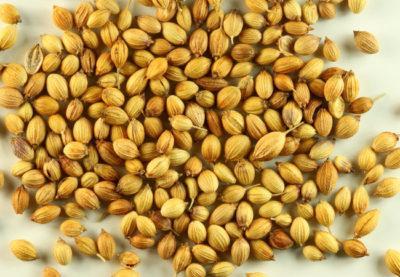

Whichever method is chosen for planting, it must be borne in mind that the planting material must be healthy, free from diseases and pests:
- various kinds of root rot;
- nematodes;
- aphids.
Tubers need to be chosen even, not large. The ideal size for planting tubers is about the size of a hen's egg. If the tuber is large, it can be cut into several pieces. The only condition is that each part must have at least three eyes. Slices must be treated with charcoal.
Agrotechnics
Jerusalem artichoke agrotechnics is simple and similar to potato agrotechnics. Jerusalem artichoke is undemanding to growing conditions, winter-hardy, grows in southern and central Russia to the latitude of St. Petersburg. In the conditions of Central Russia, it can die in severe winters, although in areas with a milder climate (for example, the Pskov region, northern regions of Tatarstan) it grows steadily.
Jerusalem artichoke and its hybrids are short-day plants, light-loving, tolerate temporary drought well and are considered very hardy crops.
Soils for Jerusalem artichoke are suitable for any, except for saline, strongly acidic and waterlogged. But the best are light loamy and sandy loam soils with a deep and cultivated arable layer and good moisture. Plants respond well to soil improvement with humus and mineral fertilizers.
Propagated mainly by tubers - seeds in the North and in central Russia do not ripen.
Planting in early spring to a depth of 6-12 cm (in autumn - 10-12 cm), in rows after 60-70 cm and 40-50 cm in rows. They are usually planted in specially designated areas (hatch wedges). Where there is usually an excess of moisture, it is better to plant the tubers in pre-prepared ridges, and in an arid strip - in a furrow.
Care. Before and after the emergence of shoots, the aisles are loosened, hoeing two or three times, and spudding in the zone of sufficient moisture. On the site of long-term cultivation, excess plants are removed and the correct rows are restored by transplanting. Then the aisles are processed, fed.
It is not recommended to enter the crop rotation. A perennial crop is possible in one area, up to 30-40 years and more (with annual fertilization with mineral fertilizers). The area is cleaned by mowing the shoots and digging them onto a full bayonet with a shovel at the moment when the old tubers have already died out, and the young ones have not yet formed.
Jerusalem artichoke pests - bears, wireworms, caterpillars of various scoops - cause minor damage to plants and are rare.
The above average yields of tubers are 40-50 t / ha, tops - 30 t / ha. Autumn harvest tubers are very poorly stored.Jerusalem artichoke is often dug up as needed, since it is stored better in the ground, and during snowy winters, they tolerate frosts of -40 ° C. The aerial part of the plant is cut off with light frosts (just before the snow), but not all at once - a small part of the trunk is left by winter so that nutrients are transferred to the tubers. Spring digging of tubers is preferable to autumn, since vitamins are completely preserved in them.
Hybrids and varieties
More than 300 varieties and hybrids of Jerusalem artichoke are known in the world. Some are distinguished by a large yield of tubers, others - of green mass (with small tubers), others - by a special decorative effect, etc. In Russia, the most famous nowadays varieties of Jerusalem artichoke are 'Kiev White', 'Red', 'Spindle-shaped', 'Patat', ' Maikopsky, Bely, Skorospelka, Nakhodka, Volzhsky 2, Vadim, Leningradsky, North Caucasian, Interest.
Only 2 varieties are cultivated industrially in Russia: Skorospelka and Interest.
- 'Skorospelka' is an early ripening variety that yields a crop of tubers by the end of September, which allows it to be cultivated in central Russia. The average yield for tubers is 25-30 tons per hectare, for green mass - 30-35 t / ha.
- ‘Interest’ is 1.5-2 times more productive than ‘Skorospelka’, but the tubers ripen only in November. Does not ripen in tubers in the middle lane.
At the beginning of the 20th century, ESBE provides the following data [15]:
| Yield from a tithe of pounds: a) tubers - 400-1300, average - 600, the highest known - 3750; b) tops - 250-800. |
By crossing Jerusalem artichoke with sunflower, a new plant was created - Jerusalem artichoke. For the first time such a crossing was carried out in the USSR. At the Maikop experimental station of the VIR, N. M. Pasko bred a variety of topin sunflower "Delight" (ZM-1-156). The tubers of this variety are large, oval, with a smooth surface. The yield of tubers reaches 400 centners per hectare or more, green mass - 600 centners / ha. K: Wikipedia: Articles without sources (type: not specified)
Cleaning and storage
The harvest begins to be dug up from the middle of autumn, since until October, nutrients are transported from the stems to the tubers. The green mass should be removed before the onset of cold weather, leaving hemp 4-7 cm high.
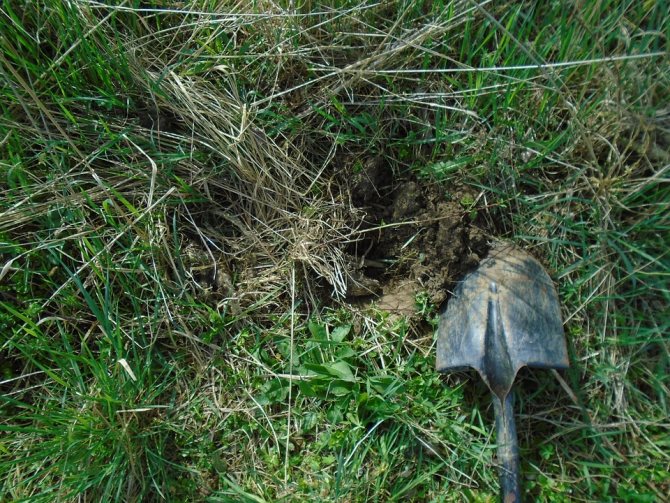

The earthen pear has one remarkable property - it is not afraid of frost. Tubers winter well in the soil, and in spring they start to grow. Therefore, many gardeners leave part of the crop in the ground. In the spring - during the period of the scarce vitamin composition of the lion's share of vegetables, the dug up tubers become a valuable addition to the menu.
If Jerusalem artichoke is grown to obtain green mass for livestock feed, the first mowing is carried out when the tubers grow to the size of an acorn. The second cut occurs at the end of August. At the beginning of the growing season, the green mass of Jerusalem artichoke grows slowly, the growth of greenery increases only in July. In the northern part of the country, shaded plantings increase tuberization - this must be remembered.
Pig breeders note: in the spring, pigs can be released to the sites with Jerusalem artichoke - they are looking for and willingly feed on root crops. In autumn, the mowed green mass is used as feed for pigs. If you plan to arrange a pasture for pigs, be guided by the following standard - 7 squares per adult.
Root vegetables collected for human consumption are stored in pits or in cellars, where the temperature does not rise above 2 degrees. To prevent the tubers from drying out, they are sprinkled with sand.
We wish you a rich harvest of "earthen pear" and more often include Jerusalem artichoke dishes in the family menu.
Timing
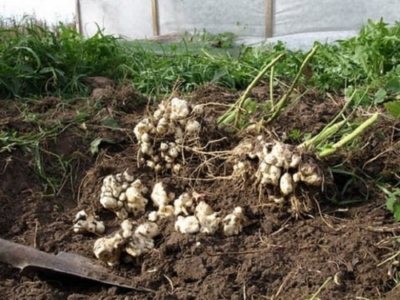

Even experienced gardeners may not know how and when to plant an earthen pear for the winter. It's better to hurry up with landing, especially if winter is on its way. You need to do planting a few weeks before the first frost, the optimal time is considered to be the beginning to mid-October.Colds are not terrible for tubers, and in spring, rooting will enter an active phase immediately after warming up the soil. The planting material is able to withstand frosts down to -30 ℃, but the sprouts die already at -5 ℃.

